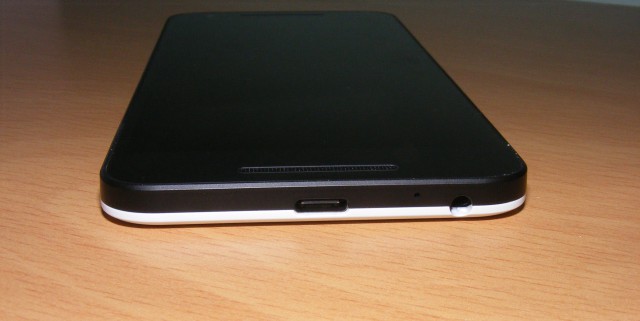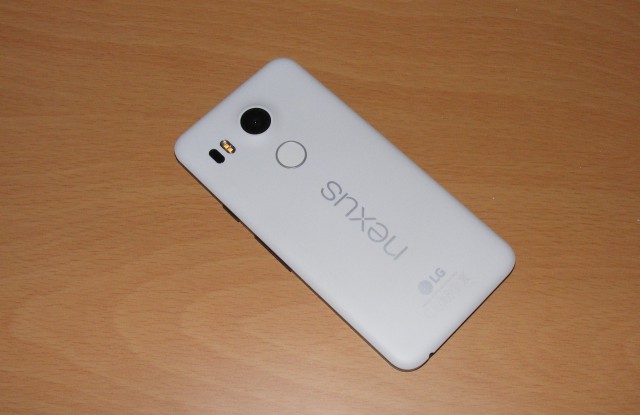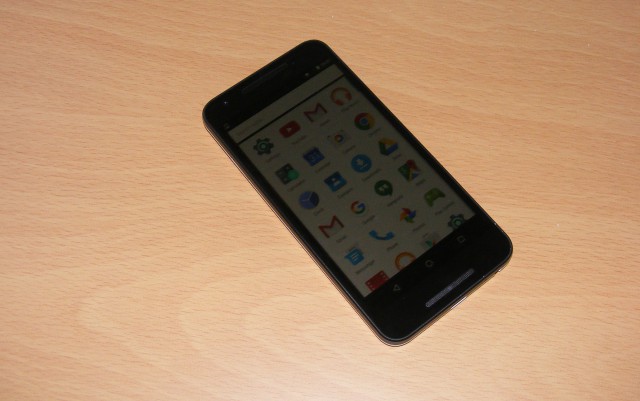Google Nexus 5X: An Android Marshmallow smartphone worthy of your attention [Review]

Phones have been gradually getting bigger in the past few years. That makes for better displays for watching videos and viewing documents and web pages, but there’s a downside too.
For many people it makes them more awkward to carry around and can mean they’re harder to use as a phone because you need two hands to operate them.
Bucking the trend somewhat the latest Nexus 5X is at the compact end of Google’s smartphone range, with a 5.2-inch display. It would be easy to dismiss this phone as a budget option, but in fact although it’s small it isn’t short of features and it has a lot to offer for business and personal users alike, so let’s take a closer look at its features and how it works.
In the Box
Although it’s sold under the Google name, the Nexus 5X is actually manufactured by South Korean electronics giant LG and it has that company’s subtle branding on the back. The package is pretty minimalist and contains just the phone itself plus a mains charger and USB cable. Note though that the cable is USB-C at both ends rather than the more usual standard USB to microUSB that you get on Android phones. So if you want to connect it to your PC you’ll need an adaptor, Google will sell you one for an extra £10.99.

There are no printed instructions included, just a card with graphics explaining how to insert a SIM card and connect the charger. You do get a little tool in the pack to allow you to open the nanoSIM slot.
The design of the phone is quite smart with an all-glass front that has no physical buttons and is pierced by speaker and mic grilles top and bottom. Its slim at just under 8mm, slightly more if you take into account the bulge around the camera lens. There’s a thin black plastic surround which has power and volume buttons on the right-hand edge and the SIM card slot on the left. USB and headphone connectors are on the bottom edge. The back, white (quartz in Google speak) on our review unit but blue and black versions are available too, has a slightly raised area around the camera lens and below that a ring surrounding the fingerprint sensor.
The back is plastic but it has a smooth matt finish which is pleasant to touch and has rounded edges so it’s comfortable to hold too. Viewed from the edge the black and white combination makes it look like a thin Liquorice Allsort.

The screen has a 1920 x 1080 resolution (1080p) and narrow edges at the sides which provide a good usable area. Under the skin there’s a 1.8GHz hexa-core processor (Qualcomm Snapdragon, with four cores at 1.4Ghz and two at 1.8GHz, for people who like to know these things), plus an Adreno GPU, you get 2GB of RAM and either 16 or 32GB of storage. Our review unit was the 32GB version, note though that there’s no SD card slot so you can’t add extra storage later.
It has 12.3MP rear and 5MP front cameras, a 2,700 mAh battery and a variety of sensors including an accelerometer, gyroscope, barometer and proximity sensor. Connectivity is via 4G, Wi-Fi (up to 802.11 a/c) and Bluetooth 4.2, plus NFC. It runs the latest Android 6.0 Marshmallow and comes unlocked so it can be used on any mobile network.
Business Features
The Nexus 5X isn’t really aimed at business users but it does nonetheless have a number of features that would make it attractive to them. It offers good battery life that will get you through a full day of moderately heavy use and if you do need to charge it you can do so quickly, allowing people on the move to take advantage of quick pit stops -- provided they remember the USB-C charger.
The fact that it’s unlocked is useful too as you can use your preferred network and take advantage of whatever contracts you may already have in place. The inclusion of a fingerprint reader makes for better security and the fact that it comes with standard Android gives you a blank canvas for your business apps. Marshmallow’s app permissions feature lets you tell an app it can access stuff like location only when it actually needs it, rather than you granting blanket access at installation. This should help prevent unintended data leaks through badly written apps.
The downside for serious business use is that memory is limited and storage is not expandable so if you want to carry large amounts of business data around with you you’re going to need to look elsewhere.
In Use
With its plastic back and relatively light weight -- only 136 grammes -- it’s hard to get away from the fact that the Nexus 5X looks and feels a bit cheap at first, the power and volume buttons don’t help this impression as they have hard edges and lack positive feel. Don’t let that put you off, however, because there’s quite a lot to like.
The 5.2-inch screen means it’s comfortable to hold in one hand, with everything no more than a thumb’s span away, in this respect it’s easier to use than the larger 5.7-inch Nexus 6P. It’s also easy to slip into a pocket without it feeling too bulky or spoiling the line of your expensive tailoring.

That screen works well too with bright colors, strong contrast and good touch response though the slight vibration you get when typing to tell you a press has registered is so subtle as to be almost unnoticeable. The Nexus 5X has an Ambient Display feature that wakes the screen in greyscale when the phone is picked up or a notification message arrives. It also has adaptive brightness that optimizes the screen brightness settings to suit the available light levels. Turning this off gives you a brighter display most of the time but at the expense of battery life.
What you enjoy in vision you miss out on in sound. The single speaker is just about acceptable for ring tones or making phone calls but if you want to listen to music or watch videos you will need to use headphones in order to get decent audio quality.
Whilst it may be inconvenient in terms of what you can connect it to just at the moment -- until the standard becomes more commonplace -- one of the advantages of using USB-C is that there’s no ‘wrong way’ to connect it. The plugs work either way around so it’s less fiddly to hook things up. Its other big advantage is it enables fast charging. With the supplied charger you can plug the phone in for around 15 to 20 minutes and it gives you about a quarter of the battery capacity back, enough for three hours or so of use. Under two hours charging time will give you a completely full battery. There’s no wireless charging option though which represents a step back from the older Nexus 5.
Unusually the fingerprint sensor is located on the back rather than the front of the device, but this actually works very well being perfectly positioned to rest your index finger on when you’re using the phone. It also has that raised ring around it making it easy to locate just by touch and it unlocks the phone fast with a single press. Training it to accept new prints is also quick and easy and you can set a backup pin, gesture or password just in case.
The 12.3MP rear camera is quite impressive and takes some decent pictures even in relatively poor lighting conditions, there is a built-in flash too. You can shoot 4K video as well, though that will eat up your available storage pretty quickly at 300MB a minute, and it’s easy to switch to video mode by swiping the screen. The camera lacks features like image stabilization and burst mode that are present on the larger Nexus 6P though. The camera app too is rather limited with just a few features like lens blur, panorama and photosphere, plus an HDR mode. A useful function is that double pressing the power button when the screen is off will immediately put the phone straight into camera mode so you can quickly grab a shot. The front camera is only 5MP, but fine for making video calls, taking selfies and the like.
If you haven’t used Android Marshmallow before you won’t find it too much of a culture shock over earlier versions of the OS. It does have some nice touches though, in particular the app screen that scrolls vertically rather than sideways, making it easier to find things and better to use one-handed, and the app permissions system which makes for improved security by only allowing app access to hardware features when they’re actually required. It also has a clever ‘Now on Tap’ function that lets you Google whatever it is you’re currently looking at on screen, in any app, simply by holding down the phone’s home button. This is handy for looking up how to use a function of the settings menu for example.

You might expect that with only 2GB of RAM on board, performance would be the Nexus 5X’s Achilles heel, but in fact it’s pretty good. Moving around the interface is fluid and fast and you never feel that you’re having to wait for the phone to catch up. It does take a little while to boot up after it’s been powered off but that’s a minor niggle. That said, whilst 2GB of RAM may be okay now, plenty of other phones are coming with 4GB or more as standard and app developers will soon start to take advantage of the extra. This may not, therefore, be a phone to buy for the long term.
The battery will give you around eight hours of continuous use on a full charge so it should be fine for a working day. Standby time is more impressive though, Google quotes up to 420 hours, in part due to Marshmallow’s Doze feature which puts apps into sleep mode when it detects that the phone is stationary for a time, thus reducing power usage.
Conclusion
Overall the Nexus 5X is a bit of a mixed bag. With its plastic back and light weight it does look and feel rather cheap, particularly the power and volume buttons, but it’s actually quite robust and the smooth plastic back resists fingerprints well. It also has some good features, the screen for example is impressive and the well placed fingerprint reader makes for ease of use.

Camera performance is good too and overall it’s a nice size, balancing usability and portability. Plus of course it has the latest Marshmallow version of Android and being from Google you get it in its pure form with no bloatware and no re-skin. Perhaps the biggest drawback is the 2GB memory which limits future proofing, you’ll almost certainly want to spend the extra £40 to get 32GB of storage too.
Using USB-C only for charging is no doubt good for the long term, though a bit annoying at the moment if you’re caught with a low battery and don’t have the supplied charger with you. It’s a shame they didn’t provide an adaptor to let you use a standard USB socket rather than only offering it as an extra.
The Nexus 5X Starts at £304 for the 16GB version, the 32GB as tested is £344. That makes it competitively priced if not especially cheap. There’s a lot of competition at this end of the market and phones like the Moto X Play and OnePlus X offer similar feature sets for slightly less money.
However, the Nexus 5X is well worth including on your shortlist and with no network restrictions and an unmolested version of Android it’s a blank canvas for you to personalize to your own taste.
Pros
Quick charging
Good battery life
Android Marshmallow
Cons
Only 2GB of RAM
No SD card slot
USB-C only
ITProPortal Review: 7/10
Published under license from ITProPortal.com, a Net Communities Ltd Publication. All rights reserved.